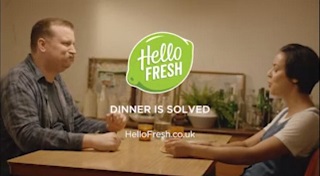4.1 Four types of informational appeal
Factual
Sometimes referred to as the ‘hard sell’ approach, factual appeals seek to provide detailed information about the product or service. It is commonly used for highly complex products or high-involvement purchases like insurance, a new car or in a business-to-business context.
For example, Xylem, a water technology provider, used a hard-hitting factual theme to convey the impact of global water consumption. It enhanced the creative execution of the advert through the endorsement of Manchester City Football Club:
Video 6: Xylem ‘Manchester City’ advert [Tip: hold Ctrl and click a link to open it in a new tab. (Hide tip)] (make sure to open this link in a new tab/window so you can easily return to this page).
Slice of life
‘Slice of life’ messaging displays the brand being used in an everyday setting. This kind of approach is common for food brands, often through a scenario of the family eating together, or, in the case of pre-prepared meals, the rushed and harried family utilising the time-saving benefits of convenience food. HelloFresh, and other home delivery recipe box services, play on this type of appeal very effectively:

Transcript: Video 7: HelloFresh ‘Dinner is solved’ advert
Demonstration
Demonstration messages often adopt a problem-solving approach in which the product or service is shown to be instrumental in resolving a problem. This type of approach is popular for promoting product categories such as over-the-counter medicines; an ailment is eased through the use of a particular medication.
These messages are equally common for promoting cleaning and household products. For example, Dyson promotes its cordless vacuum cleaners by demonstrating their ability to deal with a wide range of surfaces and debris:
Video 8: Dyson ‘Official Dyson’ advert (make sure to open this link in a new tab/window so you can easily return to this page).
Comparative
Comparative advertising is employed where the objective of the campaign is to positively position the offering against that of the competition. Financial services, utility providers and supermarkets often employ such an approach.
This kind of appeal is also popular in consumer electronics markets, where organisations will often situate the merits of their offerings against the perceived limitations of their competitors. A good example is Samsung’s long-running campaign situating its range of Galaxy smartphones against the Apple iPhone:
Video 9: Samsung ‘Upgrade to Galaxy’ advert (make sure to open this link in a new tab/window so you can easily return to this page).
Activity 5 Analysing informational appeals in advertising
Choose one of the factual appeals above, re-watch the associated advert, then answer the following questions.
- i.Why do you think the organisation chose that type of appeal?
- ii.Do you think it is an effective advert?
- iii.Which of the other information-based appeals could have been chosen and why?
Feedback
Exploring Samsung’s comparative appeal, here’s how you might answer the questions:
- i.Why do you think the organisation chose that type of appeal?
The market for smartphones is highly competitive, and the Apple iPhone is widely regarded as the market leader. However, as a piece of technology, the iPhone often lacks features offered by the competition and yet, this does not seem to impact its sales or popularity. Samsung’s strategy of comparative advertising is a good one as it allows it to show off its own product whilst also situating it against the market leader in a way that draws attention to the latter’s limitations. It also parodies the popularity of Apple products, mocking those who are willing to wait in line for a new Apple launch.
- ii.Do you think it is an effective advert?
This is a very effective advert because it achieves three objectives at once:
- it demonstrates the product
- it aims to represent the competition as an inferior offering
- it uses humour to playfully mock loyal Apple customers, playing into the wider rivalry between fans of the competing products.
- iii.Which of the other information-based appeals could have been chosen and why?
- Samsung could have used a slice of life approach, which it does touch on in this advert by showing how the product can be used in our everyday lives. It could do this very effectively without ever drawing attention to the competition. Indeed, this is more like Apple’s own advertising approach.
- It could use a factual approach, but this tends to be used less and less by consumer technology brands. Customers are less interested in the technology and more interested in what it can do for them.
- A demonstration appeal could also be used. For example, by focusing on key features such as the camera or the software. Again, there are elements of this in the advert.
